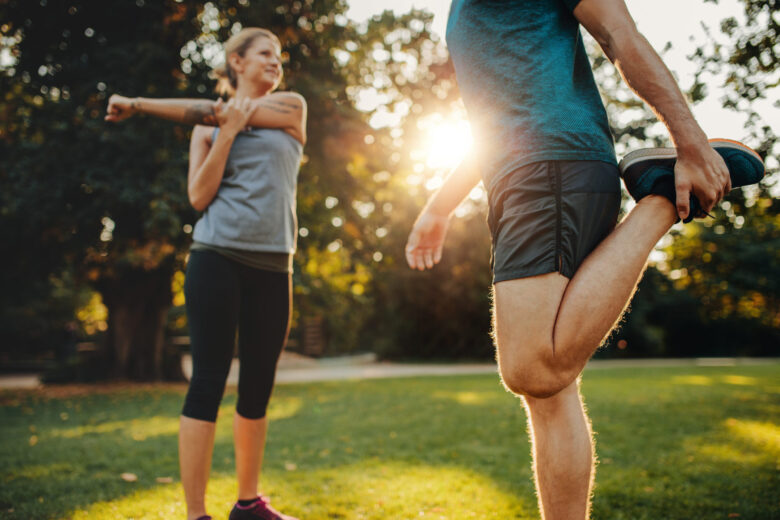Exercise is essential for maintaining your health, improving your fitness, and your overall well-being. Unfortunately, many people focus only on the workout itself and forget the importance of warming up and resting afterward. A warm-up and cool-down are essential to any good workout routine. Warming up and cooling down make it easier for the body to transition into and out of exercise, preventing injuries and improving performance. Taking a few minutes to warm up and cool down before and after exercise can significantly improve your body’s response. This applies whether you’re doing strength training, aerobics, yoga, or simply taking a walk.
The Importance of a Warm-Up
A warm-up is an essential part of preparing for exercise. It slowly increases body temperature, heart rate, and blood flow to the muscles. As the body gradually warms up, joints and muscles become more flexible and sensitive, reducing the risk of sudden injury. A proper warm-up also prepares the nervous system for exercise, allowing the body to move and react more quickly. By starting physical activity gradually instead of all at once, your body prepares itself for the upcoming activity. This not only prevents injuries but also helps you perform better.
A warm-up is good for your body
A warm-up not only prevents injuries; it has many other health benefits. Improved blood flow to your muscles helps them receive oxygen and nutrients, making them stronger and more durable during exercise. Warmed-up muscles are easier to contract and rest, making movement and training easier. A warm-up also makes it easier to perform activities that require bending, stretching, or lifting, as it makes your joints more flexible. A warm-up is crucial for athletes and others who engage in intense activities, as it ensures the body can handle the workout without excessive strain. Even for light exertion, a warm-up is important because it prepares the body for a better, easier workout.
A warm-up is good for your brain
A warm-up prepares not only the body but also the mind. Starting a workout without a warm-up can leave you feeling confused or unmotivated, but a good warm-up can help you shift your mindset and become more engaged in your workout. It gives you time to focus on your breathing, your goals, and clear your mind of distractions. A short prep period mentally prepares you for greater endurance and motivation. For many, this emotional shift is just as important as the physical workout itself, as it ensures that the body and mind are in balance for optimal performance.
The Role of Cool-Down Exercises
Just as warm-ups prepare the body for exercise, cool-downs allow the body to safely return to a resting state. Instead of abruptly stopping exercise, cool-downs gradually slow your heart rate, breathing, and blood pressure. This slow transition helps prevent dizziness, fainting, or injuries caused by excessive blood flow to your muscles. Stretching as part of a cool-down can also relieve muscle tension and stiffness, allowing them to rest after exercise. Giving your body sufficient recovery time can reduce pain and speed up the healing process. Cooling down is especially important after intense exercise, but even light exercise requires a cool-down to maintain good health.
Cooling down has benefits for the body
Some physical benefits of slowing down include increasing exercise intensity and accelerating healing. During the cool-down, hard-worked muscles relax, becoming less stiff and allowing for greater range of motion. This helps prevent further injuries and, over time, improves your balance. Cooling down also improves circulation by slowly returning blood flow to normal. This prevents lactic acid buildup and muscle fatigue. People who cool down regularly often experience less muscle soreness, making it easier to maintain their training program without being distracted by pain.
Cooling down is good for your mind
Cooling down isn’t just good for your body; it’s also incredibly beneficial for your mind. Adrenaline levels usually rise during exercise, and a good cool-down helps your nervous system return to a relaxed state. This calms you, reduces stress, and leaves you feeling refreshed instead of exhausted. Many people use a cool-down as a form of meditation, as it helps them become mindful and reflective after exercise.
Each type of workout requires a different warm-up. A warm-up for aerobic activities like running or cycling usually consists of jogging, brisk walking, or other exercises. A cool-down might consist of slow walking and stretching. A warm-up for strength training might consist of light exercises and active stretching. A cool-down, on the other hand, consists primarily of static stretching to loosen your muscles. Although yoga classes often include both a warm-up and a cool-down, it’s still important to schedule both. It’s important to choose activities that are similar to those you’d do at the gym so your body can gradually adapt.
Common Mistakes Most People Make
People often skip warm-ups and cool-downs because they don’t have time or don’t understand what they’re supposed to do. Some people don’t warm up at all or rush through it, while others stop their workout abruptly and don’t give their body a chance to recover. Another common mistake is doing static stretches before a workout instead of active stretching. This can reduce muscle effectiveness. Similarly, not stretching after a workout can reduce flexibility and increase fatigue. By prioritizing proper planning and recovery, you can avoid these mistakes, maximize your training results, and prevent unnecessary frustration.
Frequently Asked Questions about Warming Up and Cooling Down
Question 1: How long should a warm-up be?
Depending on the intensity of your workout, a warm-up takes between 5 and 10 minutes.
Question 2: Does stretching only count as a warm-up?
While stretching is good, a proper warm-up should also include movements that warm up the muscles and gradually increase your heart rate.
Question 3: Can I skip the cool-down if I’m feeling good?
Even if you feel good after exercise, you shouldn’t skip the cool-down, as it improves circulation, relieves pain, and promotes recovery.
Question 4: Should cool-down exercises be different from warm-ups?
Generally, cool-down exercises are slower and consist of static stretches. Warm-ups, on the other hand, use active movements to prepare the muscles for exercise.
Q5: Do warm-ups and cool-down exercises help prevent injuries?
Of course. They prepare the muscles and joints for exercise and relieve stress afterward, significantly reducing the risk of injury.
In summary
Warming-up and cool-down exercises are essential parts of any training program. Warming up improves flexibility, circulation, and mental acuity. Cooling down helps the body recover, relax, and reduce stress. Combined, they make workouts safer, more successful, and more enjoyable. Skipping these steps might save you a few minutes, but it can lead to an increased risk of injury, fatigue, and poorer performance. By incorporating warm-ups and cool-down exercises into your daily workout routine, you’ll get the most out of your body and mind. This extra time will help you achieve better results, feel better, and develop a stronger bond with exercise in the long run.




